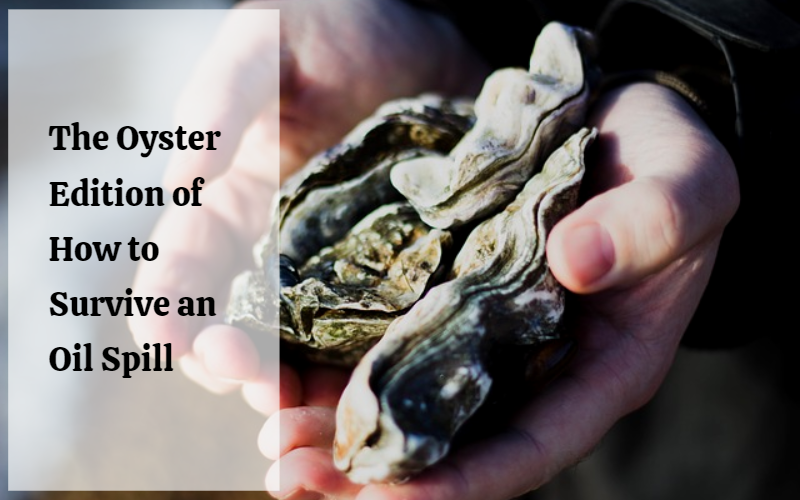The Oyster Edition : Oil Spill Disaster
Oysters are water filtration powerhouses. One oyster can filter 20 to 50 gallons of water in a single day, enough to fill a small bathtub. Snatching tiny drifting particles is how they consume. As stationary creatures, it makes sense to live in an area where plenty of food floats by. It also means that oysters must resist whatever dangers they face.
A newborn oyster looks considerably different than the shelled mollusk shucked and slurped at summertime cookouts, as it is born from the fusion of a floating egg and sperm spawned by its parents. For the first few weeks of their lives, oyster larvae are vulnerable to the whims of the tides and currents, but once they’ve matured and settled on the seafloor, they’re stuck there for the rest of their lives.
One such hazard that affected oyster beds along the Louisiana coast in 2010 was an oil leak. After an explosion that killed 11 people, the Deepwater Horizon oil disaster spewed 3.19 million barrels of oil into the Gulf of Mexico.
8.3 million oysters were likely killed along the shores of Louisiana. Scientists studied what impacts oyster survival under different conditions. The study was conducted by the Alabama Center for Ecological Resilience.
Through several experiments, they found that an oyster survived or died based upon three key factors.
Salt
An oyster’s relationship with salt follows the Goldilocks principle. In general, they thrive in coastal waters with a salinity level between 14 and 28 parts per thousand (ppt). Life gets tough for an oyster when the salinity is too high or too low.
Oysters were placed in tanks where scientists could precisely control the environment using a salty water inflow in an experiment. What happened after being exposed to oil was unexpected. Around 70% of oysters died in the moderately salty tanks, but just 5% died in the salt concentration tanks. Oysters that were exposed to a less salty, more stressful environment fared better.
In low-salt water, oysters have reduced feeding activity and are semi-comatose. Any unnecessary activity are shut down by the body so that it may focus on those that will keep it alive. The absorption mechanism of an oyster was already sluggish.
Diversity
Diversity is important in oyster ecology, as it is in most parts of life. In this case, we’re especially discussing genetic diversity. Individuals of various paternity can be found in an oyster bed. Diverse variations of the same gene create different eye hues, which is a similar concept.
An oyster bed is more likely to survive if there is a lot of genetic diversity, which means that each individual’s gene version is different from the one next to it. That way, if one gene causes an oyster to die in the face of a threat, those with a different variant will survive.
“The more genetic variation there is, the more likely some of those oysters in that population will be able to fight,” says Powers.
Dispersant
When oil spills into the ocean, it forms a massive glob at the surface. This is due to the fact that oil is hydrophobic, meaning it does not mix well with water. This makes it difficult for bacteria to break down huge amounts of oil efficiently. To help in the breakdown of oil, scientists injected a chemical into the spill, which broke up the quantity of oil into small droplets.
When dispersant was added to the moderate salinity experiment tanks, oyster death increased. Oysters exposed to both oil and dispersant died at a rate of nearly 90%, compared to 70% when only oil was used.
The Future
Only by understanding how to keep oysters healthy will we be able to help them. We can better anticipate how future oil spills may hurt oyster reefs by understanding how even minor exposure to oil and dispersant affects them, and we can take the required precautions to prevent this harm by understanding how even minor exposure to oil and dispersant affects oysters.
Although dispersant was not used within three miles of the coast, Powers observes that petroleum companies frequently lobby for its usage. Currently, states around the Gulf Coast prohibit the use of dispersant at the water’s edge.
The low salinity (near zero for months) destroyed many oysters in the Louisiana experiment. The most advantageous method would be to flood the marshes with the goal of lowering salt rather than physically forcing the oil out.
It’s too late for the oysters that lived in the bay before the Deepwater Horizon. However, with a little guidance, we may be better prepared in the event of a future oil leak. It’s the least we can do for the oysters, who do so much to keep our seas clean.
—————————————————————————————————–
The Gulf of Mexico Research Initiative (GoMRI) contributes to the development and dissemination of stories about GoMRI and oil spill science through the Ocean Portal. The Gulf of Mexico Research Initiative (GoMRI) is a 10-year independent research program that aims to better understand the impact of hydrocarbon discharges on the ecosystem and public health, as well as develop better spill mitigation, oil detection, characterization, and remediation technologies.
For More information, visit http://gulfresearchinitiative.org
Check out our oil sorbents page for more information and our previous blog to learn more about 5 ways to stop transformer oil leak.
